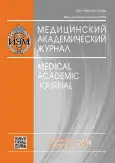USING SEQUENCE PATTERNS TO IDENTIFY AND DESIGN NEW ANTIMICROBIAL PEPTIDES
- Authors: Eliseev IE1, Terterov IN1, Shamova OV2
-
Affiliations:
- Nanobiotechnology lab, Saint Petersburg National Research Academic University RAS, Saint Petersburg
- Department of General Pathology and Pathophysiology, Institute of Experimental Medicine, Saint Petersburg
- Issue: Vol 19, No 1S (2019)
- Pages: 162-164
- Section: Articles
- Published: 15.12.2019
- URL: https://journals.eco-vector.com/MAJ/article/view/19379
- ID: 19379
Cite item
Abstract
Natural antimicrobial peptides (AMPs) are remarkably diverse, yet they all share some common structural and functional features. In an attempt to find what determines similar activities of non-homologous molecules, we performed a comprehensive analysis of sequence patterns in AMPs. We found that natural AMPs possess characteristic sequence patterns, and these patterns differ for peptides with α-helical and β-sheet structure. We showed that the patterns facilitate computational identification of AMPs in databases. We then used patterns to design new peptides, synthesized them and assayed for antibacterial activity. The most active among synthetic peptides exhibited activity against Gram(+) and Gram(-) pathogens comparable to best natural AMPs.
Full Text
About the authors
I E Eliseev
Nanobiotechnology lab, Saint Petersburg National Research Academic University RAS, Saint Petersburg
I N Terterov
Nanobiotechnology lab, Saint Petersburg National Research Academic University RAS, Saint Petersburg
O V Shamova
Department of General Pathology and Pathophysiology, Institute of Experimental Medicine, Saint Petersburg
References
- Zelezetsky I, Tossi A. Alpha-helical antimicrobial peptides - using a sequence template to guide structure-activity relationship studies. Biochim. Biophys. Acta. 2006;1758:1436-1449.
- Yount NY, Yeaman MR. Multidimensional signatures in antimicrobial peptides. Proc. Natl. Acad. Sci. U.S.A. 2004;101:7363-7368.
- Rigoutsos I, Floratos A. Combinatorial pattern discovery in biological sequences: the TEIRESIAS algorithm. Bioinformatics. 1998;14:55-67.
- Loose C, Jensen K, Rigoutsos I, Stephanopoulos G. A linguistic model for the rational design of antimicrobial peptides. Nature. 2006;443:867-869.
- Wang G, Li X, Wang Z. APD2: the updated antimicrobial peptide database and its application in peptide design. Nucleic Acids Res. 2009;37:D933-D937.
- Eliseev IE, Terterov IN, Yudenko AN, Shamova OV. Linking sequence patterns and functionality of alpha-helical antimicrobial peptides. Bioinformatics. 2018. bty1048 (epub ahead of print).
Supplementary files







